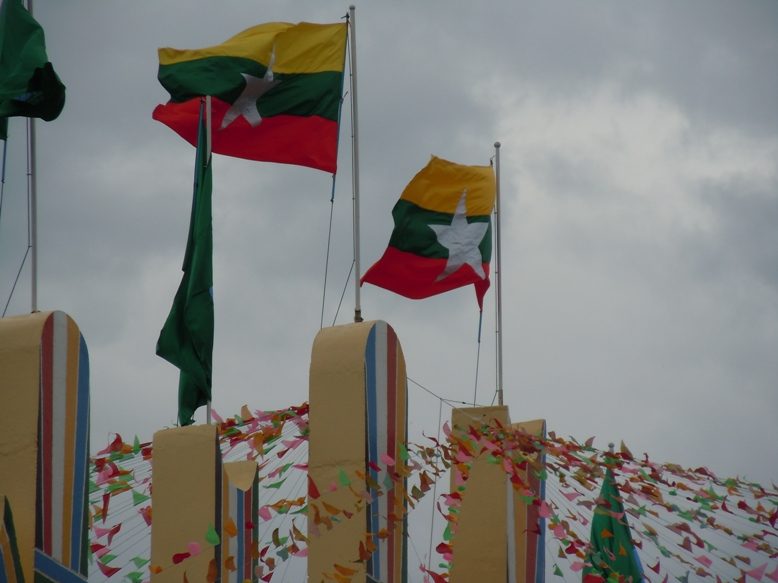This column was published at The Myanmar Times on Monday, 18 May 2015
When you have 135 official ethnic, or “national race”, categories, it’s hardly surprising that ethnic politics take up a great deal of space. Consider what happens in grandiose Nay Pyi Taw.
On the northern outskirts of the city the National Landmark Garden is a distillation of all that is good and glorious. It is a mini-version of Myanmar, with selected sights and spectacles packed into the sprawling site. On foot or in a motorised buggy, it is possible to venture from Tanintharyi to Putao, and almost everywhere in between.
The presentation of Myanmar society is predictable enough. There are stupas and mountains, palaces and forts. And across the length and breadth there are hints of ethnic flavor and diversity. Energetic tourists can even dress in their favourite minority costumes for photo-shoots. While that might seem patronising in the eyes of outsiders, it has clear appeal in a place where ethnic uniforms are standard.
On the other side of town, the hluttaw, or parliamentary, compound showcases another side of ethnic diversity. The ceremonial foyer of the upper house (Amyotha Hluttaw), which is where “national” (Amyotha) rather than “people’s” (Pyithu) representatives take their seats, has a display of mannequins to showcase Myanmar’s ethnic dimensions. The life-sized dolls are neatly adorned with all the recognisable outfits.
When flesh-and-blood representatives of minority groups attend the hluttaw, they always wear their distinctive clothes. Instead of boring business suits, the average ethnic MP takes the floor of parliament each day wearing eye-catching fabric and a distinctive headdress.
They are marked out from the crowd of USDP members, who make for a much less colourful scrum. For ethnic politicians the distinction of their clothes says a lot about the country’s history.
The basic point is that since independence in 1948 most of Myanmar’s minorities have spent at least some period in open warfare with the central government. They have fought for the chance to represent their own interests, even to run their own shows. For some groups, particularly among the Kayin, Shan and Kachin, that conflict has almost never ended. When ceasefires are agreed they tend to signal merely a pause in hostilities.
There is no escaping the fact that ethnic politics in Myanmar are the hardest politics. The government of President U Thein Sein has, unsurprisingly, found it difficult to get new policies in place. Achieving sustainable accommodations that mean minority rebels are content to live peacefully in Myanmar has remained the over-riding challenge.
In the ranks of the Tatmadaw there is also wariness. The army has long fought against internal opponents and still accuses some of seeking to destroy the sacred unity of the country. The fighting these recent months in Kokang reinforces a siege mentality. That Facebook is now awash with supportive messages for the army’s Northeastern Command is another sign of the times.
Such messages suggest that the Tatmadaw has become savvy to the value of visible popular support. While few visitors to Nay Pyi Taw ever make it out to the Defence Services Museum, which happens to be next door to the National Landmark Garden, there is a growing pride in some quarters of Myanmar society that the army keeps national disintegration at bay.
Of course, ethnic leaders, including some who take their seats in the Hluttaw, heavily contest such a view. They know the great personal and social cost of conflict, but also appreciate that many of their people still yearn for greater independence, even if they remain in a federal union.
What this means is that today’s ethnic politics point to problems not just for the current government, but also for any that follow. It was General Aung San who recognised the need for including minorities in the formation of the independent nation. It is his successors who now have the responsibility for making it work.
For now, far from the pomp and ceremony of Nay Pyi Taw, one of the first areas requiring attention is the demilitarisation in ethnic areas. In places where ethnic minorities live in large numbers, the forward deployments of the Tatmadaw are an obvious grievance.
Even when troops are well behaved and effectively disciplined, which isn’t always the case, they remain a concern. Nobody really likes living down the street, or over the ridge, from heavily armed men whose primary purpose is to stamp out dissent.
There is, all the same, a need to get the balance right between majority interests and the stakes claimed by minorities. This is sometimes framed as an economic question, but of course it has other dimensions too. There are issues of language use, access to education and the maintenance of human rights.
Given the history of political violence in Myanmar, and the prospect of its continuation, the story of minorities will also need to be told in new ways. For this mission, sites like the National Landmark Garden will prove increasingly important. If Myanmar’s fragile peace agreements are ever to become permanent then all the country’s people will need to know more about this history, warts and all.
Nicholas Farrelly is Director of the Australian National University’s Myanmar Research Centre. He is also the co-convenor of the ANU Myanmar Update Conference to be held in Canberra on June 5 to 6.
 Facebook
Facebook  Twitter
Twitter  Soundcloud
Soundcloud  Youtube
Youtube  Rss
Rss 